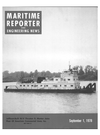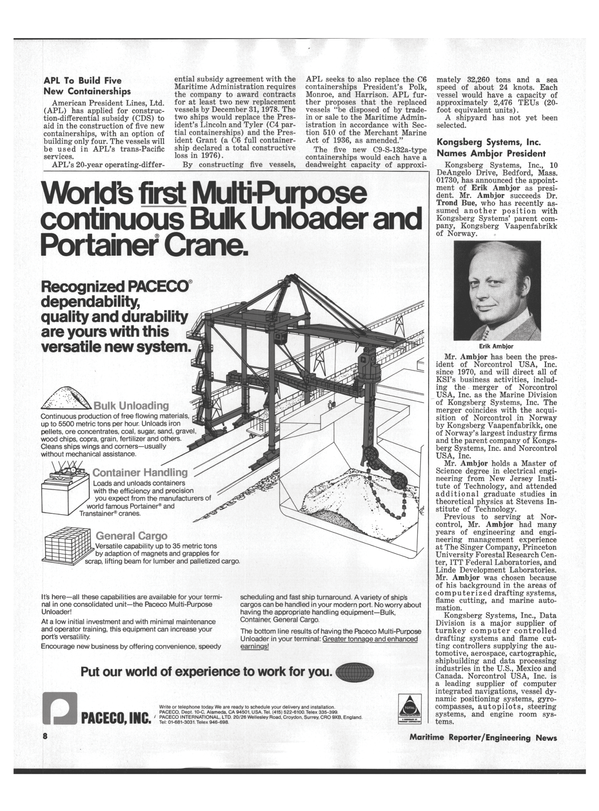
Bell Aerospace Delivers 160-Ton Air Cushion Landing Craft To Navy
The Navy has received its first advanced development air cushion vehicle, the JEFF(B), at the Naval Coastal Systems Center, Panama City, Fla.
Designed and constructed by Bell Aerospace Textron, the JEFF(B) is ready for a period of intense Navy testing. A complete checkout and shakedown of all systems has already been conducted.
The craft has a design gross weight of 325,000 pounds and has achieved speeds of more than 50 knots in the Gulf of Mexico test range. In addition, it has demonstrated ability to operate with two of its six engines shut down.
With a 50-knot over-water speed, coupled with the ability to proceed beyond the water's edge to offload a 60-ton payload of tanks and heavy artillery inland, the JEFF Craft will pave the way for adding an essential new dimension to Navy/Marine Corps amphibious assault capability.
This flexibility can be translated into tactical surprise, increased survivability and a rapid buildup of forces ashore by the amphibious forces of the future.
The JEFF Craft are the largest (in terms of design weight) military hovercraft in the world. They stand at the perimeter of known technology for ACVs. The craft will demonstrate new technology with unique subsystems, and during tests and trials will also demonstrate the military effectiveness of the concept of employing air cushion vehicles in amphibious assault. The best features of the JEFF (A) and JEFF(B) will then be combined to design and build a production configuration.
The follow-on design and procurement of fleet hardware will be accomplished under the Landing Craft, Air Cushion (LCAC) Acquisition Program.
Another craft, the JEFF (A), which is being constructed by the Aerojet Liquid Rocket Company, will be delivered to the Navy this month. The two craft use very different technical approaches to meet the same set of performance requirements. Each will carry more than 60 tons of payload.
Developed under the Navy's Amphibious Assault Landing Craft (AALC) Program, the JEFF Craft have been designed to operate from the well decks of amphibious ships. Riding on a cushion of air a few inches above the surface of water or land, the craft will be able to transition from the sea through the surf and across the beach to offload cargo—men, vehicles and equipment—on hard ground. With these c r a f t , the Navy will develop the technology and demonstrate the feasibility and military utility of employing ACVs in an amphibious assault.
P r e s e n t i n g the key to the JEFF(B) for Bell Aerospace Textron at the July 28 ceremony was John Kelly, vice president, New Orleans, Operations, and Robert Postle, Bell's program manager throughout the design and construction of the craft.
Accepting the key to the JEFF(B) for the Navy was Jeffrey Benson, the Naval Sea Systems Command AALC program manager in Washington, D.C.
Mr. Benson's remarks included congratulations to the Navy and to Bell personnel for their outstanding individual and team efforts, and a special note of appreciation to the families of all involved for t h e i r support in achieving this important milestone.
The key to the craft and custody for its operations and maintenance were t r a n s f e r r e d to Comdr. Wallace G. Wilder, USN, the officer-in-charge of the AALC Experimental Trials Unit, a field activity, and representative of the Commanding Officer, David W. Taylor Naval Ship Research and Development Center, located at Carderock, Md.
Also on the podium for the delivery ceremony were Melvin M.
Brown, AALC Program technical manager at DTNSRDC, Carderock; Casey Forrest, the current Bell AALC Program manager; Comdr. William A. Rehder, USN, Supervisor of Shipbuilding, Conversion and Repair, New Orleans, La.; Frank Higgins, manager of Test Operations of the AALC Experimental Trials Unit, and Lt.
J.N. Mullican, USN, Officer-in- Charge of the JEFF(B).
Lieutenant Mullican, USN, BMI C.L. Groover, and Adm. R.M.
Green, members of the ETU, accepted the key, started the craft, brought it up on cushion, turned and proceeded down the ramp onto beautiful St. Andrew Bay for the first mission under complete Navy control.
Read Bell Aerospace Delivers 160-Ton Air Cushion Landing Craft To Navy in Pdf, Flash or Html5 edition of September 1978 Maritime Reporter
Other stories from September 1978 issue
Content
- Marine Engineering Firm Formed In Oregon page: 4
- Jurong Shipyard Ltd. Awarded Multimillion Conversion Contract page: 4
- Data Sheet Describes Shipboard Interior Fireproof Panels page: 4
- Jeffboat Delivers The Thruston B. Morton page: 6
- Bell Aerospace Delivers 160-Ton Air Cushion Landing Craft To Navy page: 6
- Avondale To Construct Two Multi-Product Ships For Ogden Marine page: 6
- Orion Gautreaux Named Zapata Vice President page: 6
- Rhine-Schelde-Verolme And IHC Offshore Yard Effect Shipbuilding Merger page: 7
- APL To Build Five New Containerships page: 8
- Kongsberg Systems, Inc. Names Ambjor President page: 8
- Eagle Dredging Awards $25-Million Contract To Avondale Shipyards, Inc. page: 8
- Newfoundland Headed For Major Economic Advances In 1980s page: 9
- Tracor Marine Awarded $3.6-Million Navy Contract page: 10
- Sheridan Lee Opens New York Office page: 10
- ALRC Gets $13-Million Award To Supply Pumps For Boeing-Built Ships page: 10
- W.E. Christiansen Jr. Joins St. Louis Ship page: 10
- PSI Completes Total Package Concept With Todd 'Apache' Contract page: 12
- Third Generation Ro/Ro Subject Of New York SNAME Section Meeting page: 14
- John Smith Named Yard Operations Director At NASSCO page: 14
- MarAd Study Examines Shipping Policy Options page: 14
- Three-Day Maritime Safety Meeting Set For Chicago October 2-4 page: 15
- Cargo Security Study Sponsored By Government page: 16
- Todd Pacific Shipyards Launches Guided Missile Frigate Wadsworth (FFG-9) page: 16
- J. Ray McDermott & Co., Inc. Delivers 126-Foot Tug To Louisiana Tugs Company page: 16
- First Crab Boat Built By Halter Marine, The 150-Foot Alaskan Enterprise, To Operate In Bering Sea For Francis Miller page: 16
- Agri-Trans Names Miller Director Gulf Operations page: 17
- Robert Hague Post Honors James A. Farrell Jr. page: 18
- Boeing Awards Six Hydrofoil Contracts Totaling $4,360,000 page: 18
- Hongkong United Dockyards Ltd. (HUD) Forms New Subsidiary page: 18
- NKK Signs Agreement With Baker Marine Corp. page: 20
- Women Invade Engineers' Seagoing Dredge Fleet page: 20
- Uniflite Awarded $3.2-Million Navy Contracts For Target Boats page: 22
- Technical Report On Mooring For LNG Ships Released By MarAd page: 22
- Port Electric Named Marine Distributor By Jeamar Winches Ltd. page: 22
- Perry Oceanographies Designs And Builds New Undersea Work System page: 23
- 'Ocean Trade And Transport Of Phosphate Rock7 page: 24
- Samson And SMATCO Join To Expand Traction Winch Market page: 24
- Captain Tom Smith Forms CTS And Associates page: 24
- Charles Lehman Elected ACBL Vice President page: 24
- Swann Oil Relocates New York Office page: 24
- IMODCO Receives Third Contract From PEMEX In Two-Month Period page: 24
- Salen & Wicander Opens Office In United States page: 25
- Zapata Corporation Announces Senior Management Promotions page: 25
- J. Leslie Goodier Joins Battelle In Marine Technology page: 26
- Charles G. Kiskaddon Named President Alcoa Steamship page: 26
- James H. Sanborn Joins Interstate And Ocean Transport Company page: 26
- John J. McCarthy Joins Waukesha Engine Div. Dresser Industries, Inc. page: 27
- lotron Corporation Introduces Automatic RPM/Speed Converter page: 27
- Peoples' Republic Of China Concentrates On Building Up Bulk Carrier Fleet page: 28
- L. James Gardner Joins Bath Iron page: 29
- Castle & Cooke, Inc. Plans Purchase Of Seven Ships page: 29
- Halter Marine Announces Corporate Name Change page: 30
- Dravo SteelShip Names Frank C.A. van Bentem 30 Maritime Reporter/Engineering News Engineering Director page: 30
- Nominations Are Open For Shepheard Award For Maritime Safety page: 30
- Human Element In Ship Operation Is Subject Of Maine Maritime Seminar page: 30
- Halter Marine Adds Tenth Shipyard page: 30
- API Annual Tanker Conference To Be Held At Tarpon Springs Oct. 1-4 page: 32
- Paceco International Appoints Alan Holme Managing Director page: 32
- Cuba Takes Delivery Of Third Canadian-Built Ship page: 34
- Smit Nymegen Corporation Holds Seminars On Independently Fired Inert Gas Generators page: 34
- Raymond Subsidiary Awarded $10-Million Contract In Venezuela page: 36
- Port Everglades Foreign Trade Zone Expansion Approved page: 36
- Canadian Shipbuilding Production Summary For First Six Months page: 36
- Gulf Mississippi Adds Two Vessels To Fleet For Offshore Service page: 38
- Lennart Thorell Joins Todd Pacific Shipyards page: 38
- Marine Concrete Structures Delivers First 2 Platforms From New Dock Facility page: 38
- Halter Marine Delivers First Of Three Supply Boats To Brazil —First From U.S. Shipbuilder page: 40
- The 1,000-Foot M/V George A. Stinson Joins National Steel's Fleet Of Ore-Carrying Vessels page: 40
- Australian Designs Fast 1,600-Ton Containership With Crew Of Only Five page: 40
- Davie Shipbuilding Buys Branch Lines, Operator Of Tankers page: 42
- Michael Kenney Named President Of Jacksonville Propeller Club page: 42
- SNAME Gulf Central Section Told How A Load Line Assignment Is Obtained page: 43
- Repairing Vessels Since 1834, Camden Ship Repair Company Starts $4-Million Expansion page: 44
- API President Suggests That Oil Firms Should Participate In Solving U.S. Energy Dilemma page: 44
- ITT Decca Marine Forms New Marketing Services Department page: 45
- $4.5-Million Loan For Northern Metals Marine Terminal page: 46
- Robert Ivey Joins Mississippi Marine Towboat Corporation page: 46
- World And U.S. Bulk Shipping page: 46
- Bay Shipbuilding Delivers Bulk Carrier M / V Buffalo To American Steamship Company page: 47
- Navy Awards IMODCO Development Contract For Portable SPM page: 48
- Waukesha Engine Names Donald E. Bates To Sales Post in Kuwait page: 49
- APL Names Kenneth Passe Mgr. Offshore Operations page: 49
- The Effect Of The 1978 IMCO Tanker Safety And Pollution Prevention Conference On Ship Design And Operation page: 49
- James Sweat Joins Matzer Associates page: 49
- Offshore Logistics, Inc. Announces Earnings For The Year Ended June 30 page: 49
- Tokyo Marine Services Starts Trans-Pacific Drydock Tow page: 50
- Quaker Chemical Corporation Acquires Selby, Battersby— David Kollock Named President page: 50
- Maritime Transportation Research Board Names Five New Members page: 50
- Francis A. Martin And Ottaway, Inc. Name Norman Jensen Partner page: 50
- Francis W. Bauer Joins ORBA Corporation page: 51
- Largest Vertical Submerged Screw Pumps Successfully Tested At Delaval Turbine page: 52
- Jardine Plans To Restructure Oilfield Servicing—New Name Jardine Offshore Promet page: 52
- Sea-3, Inc. Names Two New Vice Presidents page: 53
- California SNAME Sections Announce Joint Meeting page: 56
- Offshore Floatel To Accommodate 600 Workers page: 58
- Biehl & Company Opens Tenth Office In Atlanta, Georgia page: 58
- Acadian Supply Files Amended Application For Towing Vessels page: 59
- Port Everglades Propeller Club Installs Officers page: 59
- Italian Government Honors Worthington Pump Chief Executive page: 60
- Overseas Shipholding Group Reports Increased Earnings page: 60
- MARCO 'Modularizes' U.S. Navy Oil-Spill Skimmers For Easy Transport By Aircraft And Truck page: 61


